
|

1982 RECIPIENT
Micheline Beauchemin — Painter-Weaver
About the craftsperson
|
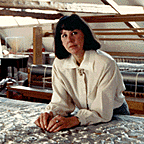
|
"Micheline Beauchemin is an artist who knows no bounds. She calls herself
a painter-weaver, but several of her works, like the one in the
Cambridge Center, more closely resemble sculpture. Others are more like
mobiles, in constant movement, responding to every current of air.
Sometimes she weaves with metallic yarns, creating such works as Winter, a
gift to the president of France, or White Totem, which was given to the
wife of the president of Egypt, or Dark winged Carapace, which adorns the
Centre industrial et culturel in Paris. By allying herself with the
boldest architects, she ensures that they design surfaces in their
buildings for her tapestries to occupy or provide spaces in which her huge
three-dimensional works will be at home. Give her walls, open cathedrals to
her...."
Guy Fournier
Writer
Montreal and Paris
|
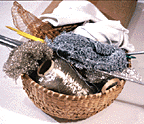
|
For Micheline Beauchemin, the process of artistic development has always
been free spirited and continuous. Her passionate pursuit of creative
expression has generated self-directed study and the mastery of several
crafts in many different parts of the world.
Speaking of her early training at the École des beaux-arts de
Montréal, she praises the creative and open-minded instruction of
Alfred Pellan and Jean Benoit. In Paris, she studied drawing and
stained-glass making, and at Mistras, Greece, renewed her convent - school
skills in embroidery. At Chartres, France, Beauchemin hooked her first rugs
and tapestries.
|
|
Returning to Montreal, she worked as a costume designer for stage and
television, and became interested in the creation of theatre curtains.
Unfortunately, neither the technology nor the opportunity to do such
large-scale weaving was available to her at that time in Canada.
Undeterred, Beauchemin travelled to Japan, where artisans working on the
wall restoration of the Imperial Palace introduced her to the craft of
large-scale weaving and also to Japanese fibres.
|
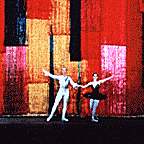
|
Opera curtain, 1966, 1969
Nylon monofilament
15 m x 27 m
National Arts Center, Ottawa
Image used with permission of the artist
Archives - Box 592, F9
|

|

|
On the basis of woven samples prepared during this visit and subsequent
trips to Japan, Beauchemin won contracts to design and construct two
massive theatre curtains, one for the Opera of the National Arts Centre in
Ottawa and the other for the Place des Arts in Montreal.
The success of these major undertakings confirmed Beauchemin's artistic
future as a weaver, and enabled her to continue pushing back the boundaries
of traditional weaving.
|
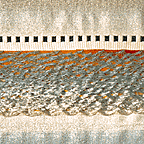
|
Homage to the St-Lawrence River, 1985
silk and metallic threads
acrylic filaments
Woven
292 cm x 145 cm
CMC 86-8 (Bronfman)
|

|
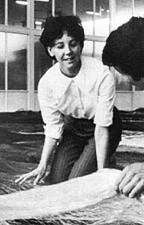
|
Beauchemin working with assistants
on the Opera curtain tor the
National Arts Centre, Ottawa
in Kyoto, Japan, 1968
|

|
|
Beauchemin has taken weaving off the loom, expanding its volume, length
and breadth. Traditional high-warp and low-warp woven tapestries have
evolved into double-sided mobiles and synthetic-fibre walls. Her repertoire
of materials has grown to include unique combinations of handspun wool,
silk and other natural fibres, as well as nylon, aluminum, and gold and
silver threads.
Beauchemin's continuing interest in fibre arts has inspired her to study
weaving techniques in Mexico, Cambodia, India and South America. For her,
the technical sophistication and timeless quality of prehistoric textiles
is a challenge for modern weavers. Speaking of a pre-Columbian textile, she
said:
"To see, to know that this done such a long time ago, by hand, and by
people who had the same preoccupation as I have, as we have ! . . . you
look at the textile, and you know that the question was asked three
thousand years ago, the same as you ask today, and the answer: There is no
change"
|
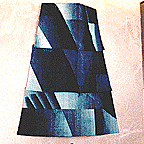
|
Sombre carapace nordique
Metallic threads, silk
15 ft. x 10 ft.
Image used with permission of the artist
Archives - Box 592, F9
|

|
|
Beauchemin nourishes this creative flow by maintaining a home base in a
restored seventeenth-century farmhouse at Grondines, on the north shore of
the St. Lawrence River. Situated near the village of Cap-Santé,
where she vacationed in her youth, the house provides a link between her
own past and her French Canadian heritage.
Within this familiar and tranquil environment, Beauchemin constructs
massive tapestries and fibre sculptures for installation in public
buildings all over the world. She has transported the ancient skills of
weaving into the modern world of fibre art.
|

